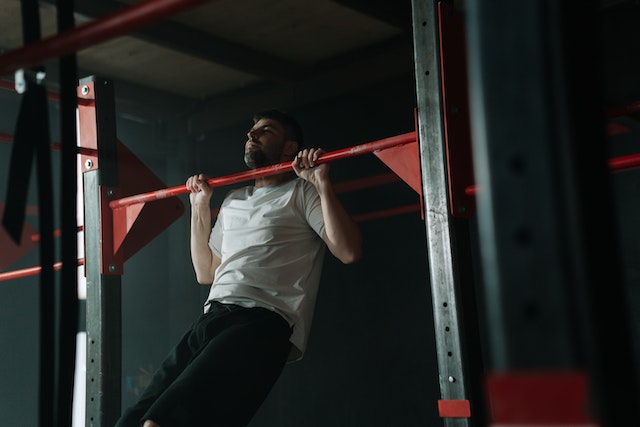Are you ready to take your calisthenics training to the next level? Resistance bands are a versatile and effective tool that can elevate your workout routine by adding an extra challenge and targeting specific muscle groups. In this article, we will explore 11 calisthenics exercises with resistance bands that will help you build strength, improve stability, and enhance your overall fitness.
Whether you’re a beginner or an experienced calisthenics enthusiast, these exercises offer a wide range of variations and modifications to suit different fitness levels. From assisting with challenging movements to adding resistance for an intensified workout, resistance bands provide the perfect complement to your bodyweight training.
Join us as we delve into the world of calisthenics and resistance bands, exploring exercises such as the band-assisted front lever, banded push-ups, band-resisted squats, band-activated glute bridges, and many more. Each exercise is accompanied by detailed instructions, proper form tips, and variations to keep your workouts diverse and engaging.
Get ready to push your limits, build strength, and sculpt your body with these 11 calisthenics exercises with resistance bands. Let’s unleash the power of resistance bands and transform your calisthenics routine into a dynamic and challenging workout experience.
Exercise 1: Band-Assisted Pull-Ups
The classic pull-up is a powerhouse exercise that targets multiple upper body muscles, including the back, shoulders, and arms. However, for beginners or individuals struggling with bodyweight pull-ups, the resistance band comes to the rescue. The resistance band assists by providing support and reducing the load, making pull-ups more achievable and helping build the necessary strength for unassisted pull-ups.
Step-by-Step Instructions:
- Secure the resistance band: Loop the resistance band around the pull-up bar and pull it through itself to create a secure attachment.
- Foot placement: Step onto the resistance band with one or both feet, ensuring it is securely positioned.
- Grip the bar: Grab the pull-up bar with an overhand grip, slightly wider than shoulder-width apart.
- Engage your muscles: Keep your core tight, shoulders down, and shoulder blades squeezed together.
- Initiate the pull-up: Start by pulling your body up, leading with your chest and engaging your back muscles. Focus on using your upper body strength while using the resistance band for assistance.
- Complete the movement: Pull yourself up until your chin clears the bar, then slowly lower yourself back down to the starting position, maintaining control throughout the entire motion.
Variations and Modifications:
- Band tension: Adjust the resistance band tension by using a thicker or thinner band to match your strength level.
- Band placement: Experiment with different foot positions on the resistance band to find the level of assistance that suits your needs.
- Eccentric pull-ups: Instead of performing full pull-ups, focus on the lowering (eccentric) portion of the movement, gradually building strength in your upper body.
- Neutral grip pull-ups: Utilize a neutral grip (palms facing each other) with the resistance band for variation and targeting different muscles.
Exercise 2: Banded Push-Ups
Push-ups are a staple exercise that targets the chest, shoulders, and triceps. By adding resistance bands to traditional push-ups, you can enhance the exercise by engaging additional muscles, such as the core and stabilizer muscles. This added resistance helps increase muscle activation and promotes greater strength gains.
How Resistance Bands Intensify the Exercise
When the resistance band is placed around your back and secured to the floor or another anchor point, it creates tension that makes the push-up more challenging. The resistance forces your muscles to work harder throughout the entire range of motion, leading to increased strength and muscle development.
Proper Hand and Band Placement
- Band placement: Place the resistance band across your upper back, positioning it just below your shoulder blades. Hold the ends of the band firmly in each hand.
- Hand positioning: Set your hands slightly wider than shoulder-width apart on the floor, aligning them with your chest.
- Body alignment: Maintain a straight line from your head to your heels, engaging your core and glutes throughout the exercise.
Performing the Exercise
- Lowering phase: Begin by bending your elbows, gradually lowering your chest towards the floor while maintaining a controlled motion. Keep your elbows at a 45-degree angle to your body.
- Pushing phase: Push yourself back up to the starting position, extending your arms fully but without locking your elbows. Focus on squeezing your chest muscles at the top of the movement.
- Repeat: Perform the desired number of repetitions, maintaining proper form and control throughout the exercise.
Variations for a More Challenging Workout
- Staggered push-ups: Place one hand on the floor slightly higher than the other, alternating between sets. This variation targets the muscles from different angles.
- Decline push-ups: Elevate your feet on a stable platform, such as a bench or step, to increase the difficulty and shift more focus onto the upper chest muscles.
- Plyometric push-ups: Explode off the ground during the pushing phase, allowing your hands to briefly leave the floor before returning to the starting position. This dynamic movement enhances power and explosive strength.
Remember to adjust the resistance band tension according to your strength level and progress gradually as you build strength and confidence.
Exercise 3: Band-Resisted Squats
Description and Benefits: Squats are a fundamental exercise for building lower body strength, improving functional movement, and enhancing overall athleticism. When combined with resistance bands, squats become even more effective. The resistance bands add constant tension throughout the entire range of motion, making your muscles work harder and promoting greater muscle activation. This helps develop stronger quads, glutes, and hamstrings.
Step-by-Step Instructions
- Band placement: Stand on the resistance band with your feet hip-width apart, ensuring the band is centered beneath the arches of your feet.
- Grip the bands: Hold the ends of the resistance band at shoulder height, crossing them in front of your body and creating an X shape.
- Squat form: Stand tall with your chest up, shoulders back, and feet slightly wider than hip-width apart. Engage your core muscles.
- Initiating the squat: Begin the movement by bending at your hips and knees, pushing your hips back as if you are sitting into a chair. Keep your weight on your heels and maintain a neutral spine.
- Squat depth: Lower your body down until your thighs are parallel to the ground or as low as your mobility allows while maintaining proper form.
- Ascending from the squat: Drive through your heels, straighten your legs, and extend your hips to return to the starting position. Squeeze your glutes at the top of the movement.
- Repeat: Perform the desired number of repetitions, focusing on maintaining proper form and controlled movements throughout.
Variations and Modifications
- Band tension: Use a resistance band with appropriate tension to match your strength level. Thicker bands provide more resistance.
- Pistol squats: Progress to pistol squats, which are single-leg squats, by performing them with the assistance of a resistance band for balance and support.
- Jump squats: Increase the intensity by performing explosive jump squats while holding onto the resistance bands for added resistance and control.
Exercise 4: Band-Activated Glute Bridges
Strong glutes are essential for overall lower body strength, stability, and athletic performance. Glute bridges specifically target and activate the gluteal muscles. Adding resistance bands to glute bridges increases the challenge and further activates the glutes. This helps in developing stronger, more toned glute muscles.
How Resistance Bands Increase Activation
By placing the resistance band just above your knees and pushing against the band throughout the movement, you create outward tension on the hips, forcing the glute muscles to engage more intensely. This activation leads to greater gluteal muscle recruitment and enhances the effectiveness of the exercise.
Performing the Exercise
- Band placement: Lie on your back with your knees bent and feet flat on the floor. Place the resistance band just above your knees and maintain tension on the band throughout the exercise.
- Hip alignment: Align your hips with your knees and shoulders. Keep your feet hip-width apart.
- Engaging the glutes: Squeeze your glutes and engage your core muscles.
- Lift the hips: Push through your heels and lift your hips off the ground until your body forms a straight line from your knees to your shoulders. Keep your knees in line with your toes and avoid letting them cave inward.
- Hold and squeeze: Pause at the top of the movement, squeezing your glutes tightly.
- Lowering phase: Slowly lower your hips back down to the starting position, maintaining control throughout the descent.
- Repeat: Perform the desired number of repetitions, focusing on proper form and maintaining glute activation throughout the exercise.
Variations for Targeting Different Areas
- Single-leg glute bridges: Lift one leg off the ground and perform glute bridges with the other leg. This variation intensifies the exercise and targets each glute individually.
- Elevated glute bridges: Place your feet on an elevated surface, such as a bench or step, to increase the range of motion and challenge your glutes further.
Exercise 5: Band-Resisted Mountain Climbers
Mountain climbers are a dynamic exercise that targets multiple muscle groups, including the core, shoulders, and legs. By incorporating resistance bands into mountain climbers, you can intensify the exercise and engage additional muscle groups. The resistance bands create continuous tension, requiring your muscles to work harder and enhancing both cardiovascular endurance and core strength.
How Resistance Bands Intensify the Exercise
By placing the resistance band around your feet or ankles and assuming the mountain climber position, you add resistance to the movement. The resistance bands engage the muscles of your legs, glutes, and core, making the exercise more challenging and effective.
Performing the Exercise
- Band placement: Secure the resistance band around your feet or ankles, depending on the band’s length and your preference. Ensure the band is securely positioned and provides enough resistance without causing discomfort.
- Starting position: Assume a high plank position with your hands shoulder-width apart and your body forming a straight line from your head to your heels. Engage your core muscles and keep your shoulders directly over your wrists.
- Mountain climber movement: Begin by pulling one knee towards your chest while keeping the other leg extended. Alternate your legs in a running motion, maintaining a controlled and steady pace throughout.
- Band resistance: As you perform the mountain climbers, the resistance band will create tension, challenging your legs, glutes, and core muscles.
- Breathing and form: Breathe evenly throughout the exercise, exhaling as you bring your knees towards your chest. Maintain proper plank form and avoid sagging or lifting your hips.
- Repetitions and sets: Perform the mountain climbers for a specific duration or a desired number of repetitions, depending on your fitness level and goals.
Modifications for Beginners or Limited Mobility
- Slow-paced mountain climbers: Slow down the movement to focus on stability and control, allowing you to maintain proper form while building strength and endurance.
- Elevated mountain climbers: Perform the exercise with your hands on an elevated surface, such as a bench or step, to reduce the intensity and provide additional support.
Exercise 6: Band-Assisted Dips
Dips are an excellent exercise for building upper body strength, specifically targeting the triceps, chest, and shoulders. However, dips can be challenging, especially for beginners or individuals with limited upper body strength. By using resistance bands for assistance, you can perform band-assisted dips, reducing the load on your muscles and allowing for proper form and controlled movements.
How Resistance Bands Assist in Performing Dips
To perform band-assisted dips, you’ll secure the resistance band around the dip bars or parallel bars and place your knees or feet in the loop of the band. The band will provide support and assistance, helping you perform the movement with more ease and allowing you to gradually build strength over time.
Performing the Exercise
- Band setup: Anchor the resistance band around the dip bars or parallel bars, making sure it’s secure and won’t slip during the exercise. Place your knees or feet in the loop of the band, depending on your preference and the band’s length.
- Starting position: Grip the bars with your hands slightly wider than shoulder-width apart and lift your body off the ground, supporting your weight on your arms.
- Band assistance: The resistance band will provide assistance as you lower your body down, reducing the load on your muscles and making the movement more achievable.
- Dipping motion: Lower your body by bending your elbows until your shoulders are slightly below your elbows. Keep your torso upright and avoid leaning forward excessively.
- Ascending from the dip: Push through your hands and extend your elbows to raise your body back to the starting position. Maintain control and avoid locking out your elbows at the top.
- Repetitions and sets: Perform the desired number of repetitions, focusing on maintaining proper form and controlled movements throughout the exercise.
Progressions for Advanced Variations
- Ring dips: Transition to ring dips, which require greater stability and engage additional muscles, such as the stabilizers in your shoulders and core.
- Weighted dips: Once you’ve mastered the band-assisted dips, you can gradually add weight by using a weight belt or holding a dumbbell between your legs to further challenge your upper body strength.
Exercise 7: Band-Resisted Lunges
Lunges are a versatile lower body exercise that targets the quadriceps, hamstrings, and glutes while also improving stability and balance. By incorporating resistance bands into lunges, you can enhance the intensity and effectiveness of the exercise. The resistance bands add resistance throughout the entire range of motion, activating the leg muscles more intensely and promoting greater strength and muscle development.
Proper Form and Band Placement:
- Band setup: Step on the resistance band with one foot, ensuring it is centered beneath the arch of your foot.
- Band grip: Hold the ends of the resistance band in each hand, allowing enough tension to create resistance during the movement.
- Lunge stance: Stand tall with your feet hip-width apart. Take a step forward with one foot and lower your body into a lunge position, ensuring that your front knee is directly above your ankle and your back knee is slightly above the ground.
- Lunge movement: Push through your front heel and extend both knees to raise your body back to the starting position.
- Repeat: Perform the desired number of repetitions on one leg before switching to the other leg.
Variations for Different Levels
- Walking lunges: Instead of stepping back to the starting position after each lunge, continue walking forward, alternating legs with each step. This variation adds an element of dynamic movement and increases the cardiovascular demand.
- Curtsy lunges: Instead of stepping directly forward, cross one leg behind the other in a curtsy-like motion. This variation targets the glutes and outer thighs to a greater extent.
Exercise 8: Band-Resisted Bicycle Crunches
Core strength is crucial for stability, proper posture, and overall functional movement. Bicycle crunches are a highly effective exercise for targeting the abdominal muscles, including the rectus abdominis and obliques. By incorporating resistance bands into bicycle crunches, you can increase the resistance and intensify the exercise, leading to greater core activation and muscle development.
Performing the Exercise
- Band placement: Lie on your back with the resistance band looped around the arches of your feet. Hold the ends of the band in your hands, crossing them over your chest.
- Starting position: Lift your feet off the ground, bending your knees at a 90-degree angle. Raise your upper body off the ground, engaging your core muscles.
- Bicycle crunch movement: Extend one leg straight while simultaneously rotating your upper body, bringing the opposite elbow towards the bent knee. Alternate sides in a pedaling motion.
- Band resistance: Throughout the movement, the resistance band adds tension, creating resistance as you pull against it, which challenges your core muscles.
- Breathing and form: Exhale as you twist and bring your elbow towards your knee, engaging your core. Maintain control and avoid straining your neck or using momentum to perform the exercise.
- Repetitions and sets: Perform the desired number of repetitions, focusing on maintaining proper form and controlled movements throughout the exercise.
Variations for Variety
- Planks: Incorporate static planks into your routine to further strengthen the core and improve overall stability.
- Russian twists: Sit on the ground with your knees bent, holding the resistance band in front of you. Twist your torso from side to side, moving the band across your body, to target the obliques.
Exercise 9: Band-Assisted Pistol Squats
Benefits and Difficulty of Pistol Squats: Pistol squats are a challenging unilateral exercise that strengthens the quadriceps, glutes, and core while improving balance and mobility. However, they can be demanding, especially for those new to the movement. By using resistance bands for assistance, you can gradually progress towards performing unassisted pistol squats while maintaining proper form and reducing the risk of injury.
Performing the Exercise
- Band setup: Anchor the resistance band to a sturdy object, such as a pole or railing, at waist height. Stand facing away from the anchor point and place the loop of the band around the front of your waist, securing it firmly.
- Starting position: Lift one leg off the ground, extending it in front of you. Maintain a straight back and engage your core.
- Squatting motion: Slowly lower your body by bending your standing leg and pushing your hips back. Keep your chest upright and your extended leg parallel to the ground.
- Band assistance: The resistance band provides support and assistance as you descend into the squat, reducing the load on your leg muscles.
- Ascending from the squat: Push through your standing heel and extend your leg, returning to the starting position. Maintain control and focus on balance throughout the movement.
- Repetitions and sets: Perform the desired number of repetitions on one leg before switching to the other leg.
Progressions for Advanced Variations
- Weighted pistol squats: Once you have developed sufficient strength, you can incorporate additional weight, such as holding a dumbbell or kettlebell, to increase the challenge.
- Pistol squat jumps: Add explosive power to your pistol squats by jumping explosively off the ground as you ascend from the squat position.
Exercise 10: Band-Resisted Plank Rows
Plank rows are a compound exercise that targets the core, upper back, and arms. The exercise improves core stability while also engaging muscles in the back, shoulders, and arms. By incorporating resistance bands into plank rows, you can intensify the exercise and target these muscles more effectively.
Performing the Exercise
- Band setup: Anchor the resistance band to a sturdy object, such as a pole or door anchor, at chest height. Assume a high plank position with your hands directly below your shoulders and the resistance band looped around one hand.
- Starting position: Engage your core and maintain a straight line from your head to your heels, ensuring that your hips are neither too high nor too low.
- Rowing motion: Pull the resistance band toward your chest by retracting your shoulder blade and bending your elbow. Keep your body stable and avoid rotating or sagging your hips.
- Band resistance: The resistance band adds tension as you perform the rowing motion, engaging the muscles in your upper back and arms.
- Return to starting position: Slowly lower the resistance band back to the starting position, maintaining control throughout the movement.
- Repetitions and sets: Perform the desired number of repetitions on one side before switching to the other side.
Variations for Added Challenge
- Single-arm rows: Perform the plank rows with one arm at a time, increasing the demand on your core and upper body stability.
- Renegade rows: Assume a plank position with both hands on the ground and the resistance bands looped around each hand. Alternate rowing each hand, engaging multiple muscle groups simultaneously.
Exercise 11: Band-Assisted Front Lever
The front lever is a challenging calisthenics exercise that targets the core, back, and upper body muscles. It requires exceptional strength, stability, and body control. However, mastering the front lever can be a daunting task for many individuals. That’s where resistance bands come in to provide the necessary assistance and help you progress towards achieving this impressive skill.
Exercise Description and Benefits
The front lever is a static hold in which you suspend your body horizontally while gripping a bar with straight arms. It primarily targets the lats, shoulders, abs, and grip strength. The band-assisted front lever allows beginners or individuals struggling with bodyweight front levers to develop the required strength and technique gradually.
How Resistance Bands Assist
Resistance bands act as a support system, reducing the weight load and providing assistance during the exercise. By attaching a resistance band to the bar and placing your feet or knees into the loop, you can create a counterbalance effect that helps you maintain the proper body position and stay parallel to the ground.
Step-by-Step Instructions
- Set up the band: Securely attach one end of the resistance band to a sturdy pull-up bar at waist height. Ensure that it is securely fastened to prevent any accidents.
- Loop placement: Step into the other end of the band with your feet or knees, depending on your comfort and strength level. The band should be positioned around your hips or lower thighs.
- Grip and position: Grasp the bar with an overhand grip, slightly wider than shoulder-width apart. Hang from the bar with your arms fully extended, engaging your shoulders and core.
- Engage your core: Activate your core muscles and maintain a straight body alignment from your head to your heels.
- Initiate the front lever: Begin by slowly lifting your legs, keeping them straight and parallel to the ground. Focus on engaging your lats and shoulder blades to maintain stability.
- Find your balance: Experiment with the angle of your body, aiming to achieve a horizontal position. Use the resistance band to support your bodyweight and find a balance between challenge and assistance.
- Hold the position: Aim to hold the band-assisted front lever for a predetermined time period, such as 10-20 seconds, gradually increasing the duration as you gain strength and confidence.
- Controlled release: Lower your legs back down to the starting position with control, maintaining tension throughout your core and back muscles.
Progressions for Advanced Variations
As you become more proficient in the band-assisted front lever, you can gradually reduce the assistance provided by the band. This can be done by using a lighter resistance band or by positioning the band higher up on your body, increasing the load on your muscles. With consistent training and progress, you’ll eventually be able to perform the front lever without assistance.
Safety Precautions
- Ensure that the resistance band is securely attached and does not have any visible signs of wear or damage.
- Start with a band that provides sufficient assistance for your current strength level. You can always adjust the resistance as you progress.
- Focus on maintaining proper form and alignment throughout the exercise to prevent any strain or injury.
- Listen to your body and gradually increase the difficulty level as your strength improves.
The band-assisted front lever is an impressive exercise that showcases your upper body and core strength. It may take time and practice to master, but with the help of resistance bands, you can steadily progress towards achieving this challenging calisthenics feat. So, grab your bands, set up your bar, and embrace the journey towards unlocking the front lever. Your dedication and hard work will pay off, and soon you’ll be defying gravity with this incredible exercise.
Final Thoughts
Congratulations! You have now discovered 11 incredible calisthenics exercises that can be taken to new heights with the addition of resistance bands. These exercises have the power to transform your body, build strength, and improve your overall fitness.
By incorporating resistance bands into your calisthenics routine, you can target specific muscle groups, add resistance for increased intensity, and even receive assistance to progress towards more challenging movements. The versatility of resistance bands allows you to customize your workouts, making them suitable for beginners and experienced individuals alike.
Remember, proper form and technique are essential for maximizing the benefits of these exercises and preventing injuries. Take your time to master the basics, gradually increase the difficulty level, and listen to your body throughout the process.
As you continue your calisthenics journey with resistance bands, don’t forget to enjoy the process. Celebrate your progress, stay consistent, and embrace the challenge of pushing your limits. With dedication and perseverance, you will achieve remarkable results.
Now, armed with the knowledge of these 11 calisthenics exercises with resistance bands, it’s time to put them into action. So, grab your resistance bands, create your workout space, and embark on an incredible fitness journey that will take you to new heights of strength, endurance, and overall fitness.
Unleash the power of resistance bands and witness the transformation of your body and mind. Get ready to sculpt your muscles, build functional strength, and unlock your full calisthenics potential. The path to a stronger, fitter you starts now!






